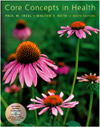Paul M. Insel,
Stanford University School of Medicine
Walton T. Roth,
Stanford University School of Medicine
| proof value | Two times the percentage of alcohol by volume; a beverage that is 50% alcohol by volume is 100 proof.
|
 |
 |
 |
| alcohol | The intoxicating ingredient in fermented liquors; a colorless, pungent liquid.
|
 |
 |
 |
| metabolism | The chemical transformation of food and other substances in the body into energy and wastes.
|
 |
 |
 |
| blood alcohol concentration (BAC) | The amount of alcohol in the blood in terms of weight per unit volume; used as a measurement of intoxication.
|
 |
 |
 |
| *cirrhosis of the liver | A disease in which the liver is severely damaged by alcohol, other toxins, or infection.
|
 |
 |
 |
| cardiac myopathy | Weakening of the heart muscle through disease.
|
 |
 |
 |
| fetal alcohol syndrome (FAS) | A characteristic group of birth defects caused by excessive alcohol consumption by the mother, including facial deformities, heart defects, and physical and mental impairments.
|
 |
 |
 |
| alcohol abuse | The use of alcohol to a degree that causes physical damage, impairs functioning, or results in behavior harmful to others.
|
 |
 |
 |
| alcohol dependence | A pathological use of alcohol, or impairment in functioning due to alcohol; characterized by tolerance and withdrawal symptoms; alcoholism.
|
 |
 |
 |
| alcoholism | A chronic psychological disorder characterized by excessive and compulsive drinking.
|
 |
 |
 |
| binge drinking | Periodically drinking alcohol to the point of severe intoxication.
|
 |
 |
 |
| hallucination | A false perception that does not correspond to external reality, such as seeing visions or hearing voices that are not there.
|
 |
 |
 |
| DTs (delirium tremens) | A state of confusion brought on by the reduction of alcohol intake in an alcohol-dependent person; other symptoms are sweating, trembling, anxiety, hallucinations, and seizures.
|
 |
 |
 |
| paranoia | A mental disorder characterized by persistent delusions-fixed, false beliefs that would not be accepted by the individual's culture.
|
 |
 |
 |
| alcohol related neurodevelopmental disorder (ARND) | Cognitive and behavioral problems seen in people whose mothers drank alcohol during pregnancy.
|



 2002 McGraw-Hill Higher Education
2002 McGraw-Hill Higher Education

 2002 McGraw-Hill Higher Education
2002 McGraw-Hill Higher Education